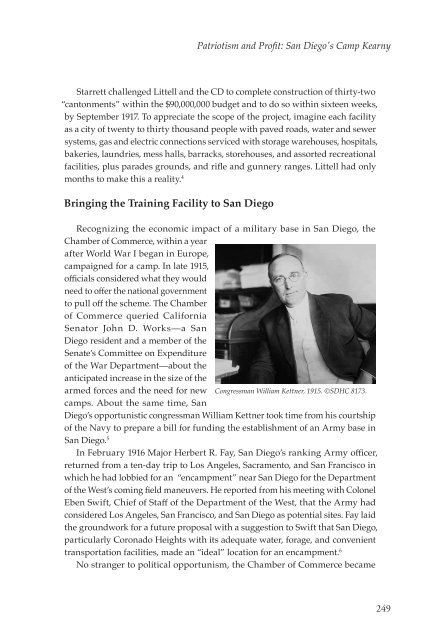Complete Issue Online - San Diego History Center
Complete Issue Online - San Diego History Center
Complete Issue Online - San Diego History Center
You also want an ePaper? Increase the reach of your titles
YUMPU automatically turns print PDFs into web optimized ePapers that Google loves.
Patriotism and Profit: <strong>San</strong> <strong>Diego</strong>'s Camp Kearny<br />
Starrett challenged Littell and the CD to complete construction of thirty-two<br />
“cantonments” within the $90,000,000 budget and to do so within sixteen weeks,<br />
by September 1917. To appreciate the scope of the project, imagine each facility<br />
as a city of twenty to thirty thousand people with paved roads, water and sewer<br />
systems, gas and electric connections serviced with storage warehouses, hospitals,<br />
bakeries, laundries, mess halls, barracks, storehouses, and assorted recreational<br />
facilities, plus parades grounds, and rifle and gunnery ranges. Littell had only<br />
months to make this a reality. 4<br />
Bringing the Training Facility to <strong>San</strong> <strong>Diego</strong><br />
Recognizing the economic impact of a military base in <strong>San</strong> <strong>Diego</strong>, the<br />
Chamber of Commerce, within a year<br />
after World War I began in Europe,<br />
campaigned for a camp. In late 1915,<br />
officials considered what they would<br />
need to offer the national government<br />
to pull off the scheme. The Chamber<br />
of Commerce queried California<br />
Senator John D. Works—a <strong>San</strong><br />
<strong>Diego</strong> resident and a member of the<br />
Senate’s Committee on Expenditure<br />
of the War Department—about the<br />
anticipated increase in the size of the<br />
armed forces and the need for new Congressman William Kettner, 1915. ©SDHC 8173.<br />
camps. About the same time, <strong>San</strong><br />
<strong>Diego</strong>’s opportunistic congressman William Kettner took time from his courtship<br />
of the Navy to prepare a bill for funding the establishment of an Army base in<br />
<strong>San</strong> <strong>Diego</strong>. 5<br />
In February 1916 Major Herbert R. Fay, <strong>San</strong> <strong>Diego</strong>’s ranking Army officer,<br />
returned from a ten-day trip to Los Angeles, Sacramento, and <strong>San</strong> Francisco in<br />
which he had lobbied for an “encampment” near <strong>San</strong> <strong>Diego</strong> for the Department<br />
of the West’s coming field maneuvers. He reported from his meeting with Colonel<br />
Eben Swift, Chief of Staff of the Department of the West, that the Army had<br />
considered Los Angeles, <strong>San</strong> Francisco, and <strong>San</strong> <strong>Diego</strong> as potential sites. Fay laid<br />
the groundwork for a future proposal with a suggestion to Swift that <strong>San</strong> <strong>Diego</strong>,<br />
particularly Coronado Heights with its adequate water, forage, and convenient<br />
transportation facilities, made an “ideal” location for an encampment. 6<br />
No stranger to political opportunism, the Chamber of Commerce became<br />
249







![[PDF] The Journal of San Diego History Vol 52: Nos 1 & 2](https://img.yumpu.com/25984149/1/172x260/pdf-the-journal-of-san-diego-history-vol-52-nos-1-2.jpg?quality=85)

![[PDF] The Journal of San Diego History - San Diego History Center](https://img.yumpu.com/25984131/1/172x260/pdf-the-journal-of-san-diego-history-san-diego-history-center.jpg?quality=85)







